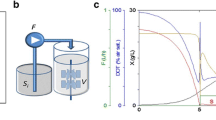Fed-batch cultures were carried out to overproduce human insulin-like growth factor I (IGF-I) in Escherichia coli. The effects of carbon sources (glucose or glycerol) and induction time on cell growth and IGF-I production were investigated in more detail. Glycerol was a better carbon source than glucose for IGF-I production in fed-batch culture. Induction at the mid-exponential phase with glycerol as a carbon source in the pH-stat fed-batch culture was optimal for IGF-I production. Under this condition, 2.8 g L−1 of fusion IGF-I was produced as inclusion bodies. We have also developed downstream processing for preparative scale purification of IGF-I from the fusion protein produced by the fed-batch culture using glycerol as a carbon source. After the fusion protein expressed was solubilized in 8 M urea and cleaved with hydroxylamine, the released IGF-I was purified by cation exchange chromatography, refolding and preparative scale reverse phase HPLC (rp-HPLC) to give recombinant IGF-I of >98% purity. The biological activities of the purified IGF-I were measured and found to be identical to those of commercial IGF-I. Journal of Industrial Microbiology & Biotechnology (2000) 24, 94–99.
Similar content being viewed by others
Author information
Authors and Affiliations
Additional information
Received 13 January 1999/ Accepted in revised form 02 October 1999
Rights and permissions
About this article
Cite this article
Chung, B., Choi, Y., Yoon, S. et al. Process development for production of recombinant human insulin-like growth factor-I in Escherichia coli . J Ind Microbiol Biotech 24, 94–99 (2000). https://doi.org/10.1038/sj.jim.2900773
Issue Date:
DOI: https://doi.org/10.1038/sj.jim.2900773




